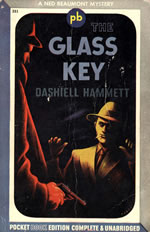The Glass Key
 Cover Artist:
Cover Artist: Leo Manso
By: Hammett, Dashiell
Publisher: Pocket Books, Inc. (211)
Place of Publication:New York, NY
Catalog #: Kelley Box 265: PS3515 .A4347 G5 1945
Contributor:
M. Brower
General
Era: 1930s
Author as on Cover: Dashiell Hammett
Publication:1945
Original Date: 1931
Setting: urban
Plot Summary
Gambler Ned Beaumont takes on high-powered politicos and their hired thugs as he attempts to keep a friend out of jail for a murder he didn't commit. While running errands for his boss Paul Madvig, a powerful city ward boss, Beaumont stumbles across the body of Taylor Henry, son of a senator Madvig is trying to forge an alliance with. Madvig is everyone's prime suspect; he and Taylor had fought over Taylor's relationship with Madvig's daughter Opal, and Taylor was standing in the way of Madvig's courtship of Janet Henry, Taylor's sister. Beaumont, however, doesn't believe that Madvig murdered Taylor, and he battles the local newspaper, Madvig's rival ward boss Shad O'Rory, and Opal and Janet in an attempt to clear Madvig of the crime. Eventually, in an almost anticlimactic confession, Senator Henry admits that he accidentally killed his own son and Madvig kept silent in order to cover for him. Beaumont, who has remained loyal to his friend and employer Paul Madvig through beatings, fights and accusations, leaves for New York, taking Madvig's love interest, Janet, along with him.
Major Characters
Ned Beaumont adult male, probably mid-to-late 30s, tall, slender, dark hair and brown eyes, mustache; ward heeler for Paul Madvig, also a gambler
Paul Madvig adult male, 40s, blonde, solidly built, professional politician (ward boss); hopes to marry Janet Henry to solidify his connection to the senator
Senator Henry adult male, older than Madvig, but not by much; professional politician
Taylor Henry adult male, probably in his 20s, apparently quite a ladies' man; seeing Madvig's daughter Opal despite Madvig's objections
Opal Madvig adolescent female, probably late teens; seeing Taylor Henry against her father's wishes
Janet Henry adult female, probably in her 20s; sister of Taylor Henry and daughter of Senator Henry
Shad O'Rory adult male, older; has white hair and a nice voice; Paul Madvig's political rival
Weapons
guns, fists, an aggressive bulldog; the murder weapon is a wooden cane.
Level of Violence
violence is treated casually and is often committed by people whose jobs require it. Some parts of Ned's beating by Jeff Gardner are very explicit; others are barely mentionbed. Gardner's murder of O'Rory is also explicit. Gardner, who is repeatedly (even tiresomely) described as "apish," is the most violent character in the book - possibly Hammett's comment on the animalistic qualities of violent men.
Sexuality
Taylor Henry has an apartment that he keeps for assignations with his lady friends, and Lee Wilshire lives with Bernie DeSpain without benefit of marriage. One scene, in which Ned is seduced by the newspaper publisher's wife while her husband is upstairs committing suicide, is fairly sultry.
Gender Roles
the four main female characters are all supported by men in some fashion. Opal and Paul's mother by Paul, Janet by her father, and Lee by a succession of young men, apparently. Opal is young and passive and doesn't seem very bright; Janet is intelligent but underhanded, writing anonymous notes to implicate Madvig in her brother's death; Lee is a stereotypical "bad girl" who gets her way by alternately cajoling and threatening men. Only "Mom" seems to be a direct and forthright person with clear priorities -- fairly common qualities in a matriarch.
Ethnicity
many of the politicos have names that at least suggest their ethnicity (Madvig, O'Rory). All characters who are described physically are apparently Caucasian.
Alcohol/Drug Abuse
lots of alcohol. Men mostly drink straight whiskey, while women drink cocktails like Lee Wilshire's "silver fizz." Jeff Gardner rather casually strangles O'Rory while drunk.
Law Enforcement
the police are mentioned rarely but sympathetically -- the police may suspect Madvig, but have stalled their investigation, either because of lack of evidence or out of fear of Madvig's power.
Added Features
this novel was originally serialized in the pulp magazine Black Mask, March-June, 1930.
Part 1: "The Glass Key," March, 1930; Part 2: "The Cyclone Shot," April, 1930; Part 3: "Dagger Point," May 1930; Part 4: "The Shattered Key," June, 1930.
Subject Headings
Corruption (In Politics)/ Gambling/ Politics/ Murder
Psychological Elements
there's very little insight into any of these characters' motivations, backgrounds, etc. They seem to exist in a very narrow period of time, most of which is within the framework of the novel, and their thoughts and feelings are mostly hidden. Hammett was apparently experimenting with a very objective, reportorial style; the story and its events have more emphasis than the characters.
Film Adaptations
The Glass Key, 1935, Paramount;
The Glass Key, 1942, Paramount
 Cover Artist: Leo Manso
Cover Artist: Leo Manso